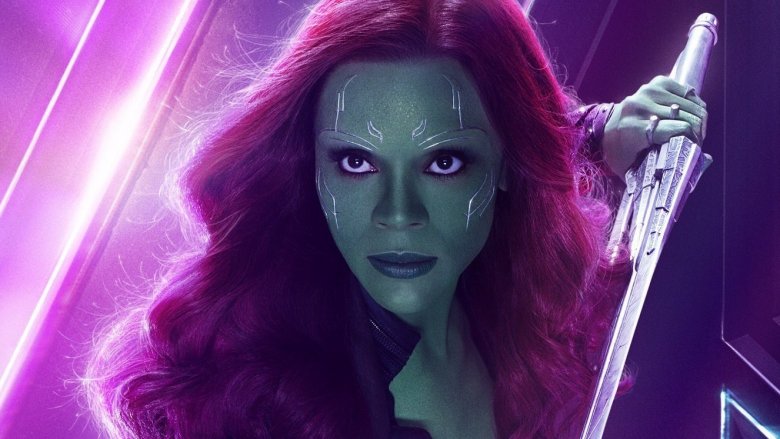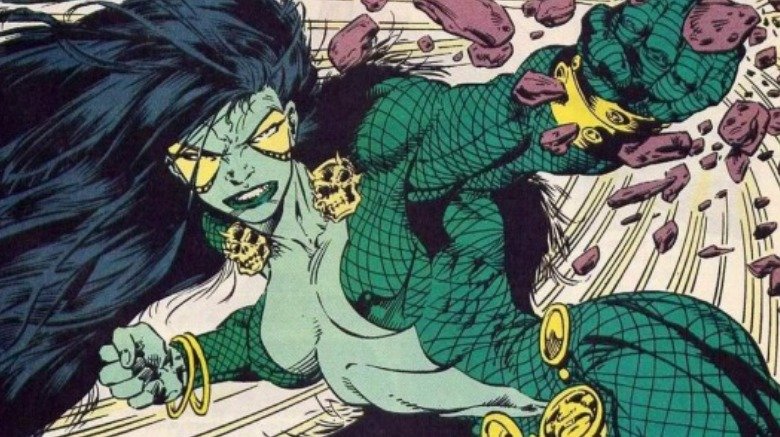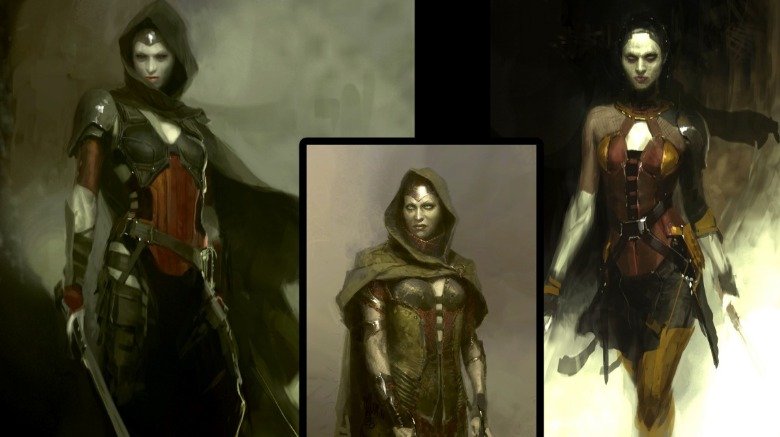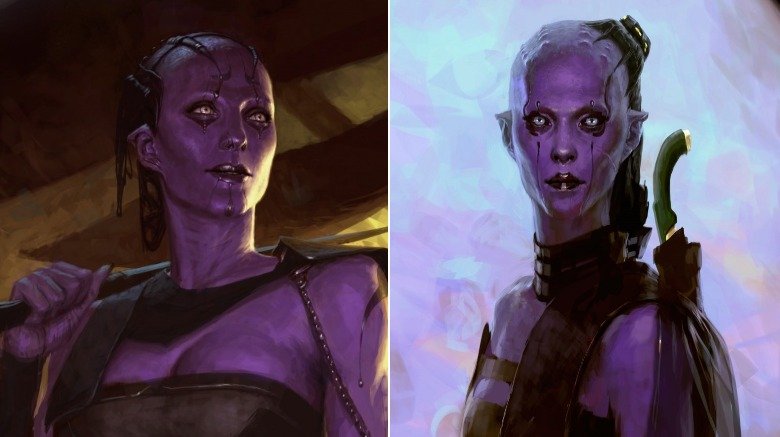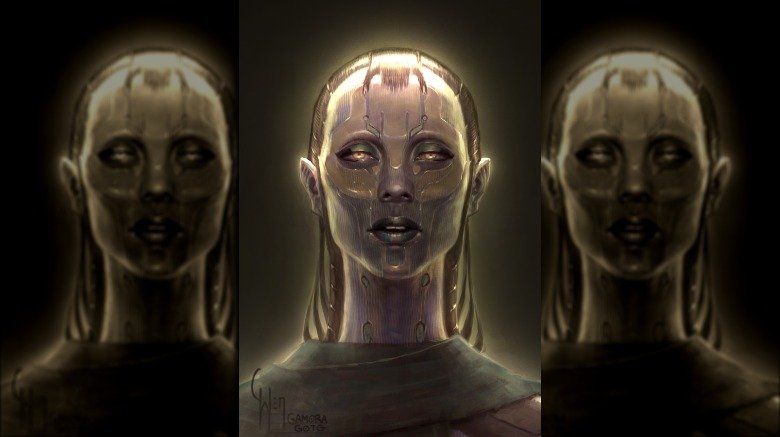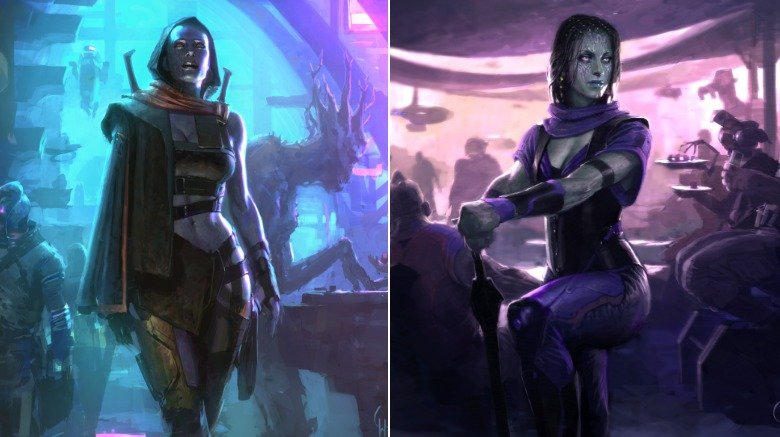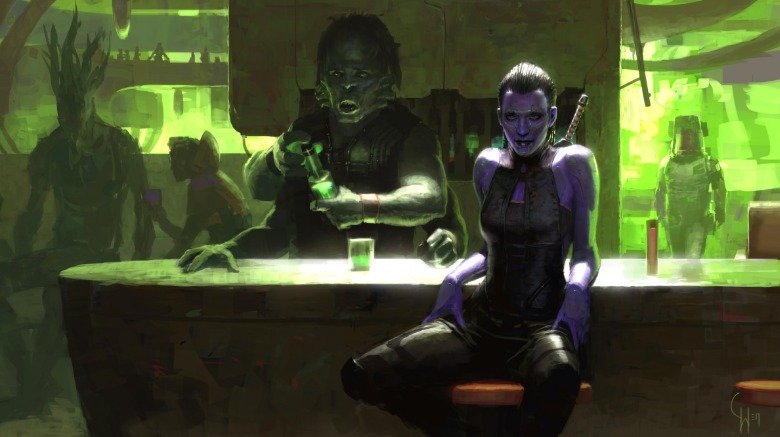What Gamora Almost Looked Like In The MCU - Exclusive
It's one thing for comics fans to critique the versions of their favorite characters that make it to the big screen, it's quite another to actually do the work of making that adaptation happen. That's just the task that Charlie Wen — former head of visual development at Marvel Studios — had in front of him when he started directing and designing concept art for 2014's Guardians of the Galaxy. And while this was a movie that included bonkers characters like a gun-toting raccoon who was best friends with a talking space tree, the real challenge lay in getting some of the less over-the-top characters just right.
Take, for example, Gamora, played by Zoe Saldana. The filmmakers had to do a lot of heavy lifting to sell audiences on caring about a character who's introduced as a villain — the adopted daughter of intergalactic despot Thanos – who soon reveals herself to actually be a hero. Wen led his team of artists — including Andy Park, Jackson Tze, Rodney Fuentebella, Anthony Francisco, Andrew Kim, Josh Herman, Justin Sweet, Kevin Chen, Jared Marez, and Ian MacCaig — through plenty of different versions of Gamora before achieving the look of the outer-space ass-kicker we know and love. Wen sat for an exclusive interview with Looper to talk about what Gamora almost looked like in the MCU.
From comics to screen
Before 2014, there's a good chance that if you said the phrase "Guardians of the Galaxy" to your average moviegoer, their reaction would be pretty similar across the board: "Who? What? Why are you talking to me?" And that's exactly what Charlie Wen was banking on when he started adapting the characters from Marvel Comics' long history of spacefaring weirdos for Guardians of the Galaxy.
"Nobody knew what Guardians was. It's very niche," Wen explained. "It allowed for a lot of exploration to create a Marvel Space Odyssey."
Wen added:
"Because world-building was such a large part of the design challenge for this film, I spent much more time defining tone and feel to establish our parameters."
That freedom to experiment is probably why the screen version of Gamora — as well as the concept art Wen created — has very little in common with the comic book depictions that have appeared in the pages of Marvel Comics over the years. "Almost looks like Poison Ivy, doesn't she?" says Wen after being shown the above image from Warlock and the Infinity Watch #8.
Geared up for adventure
Some comic book characters are relatively easy to adapt to the screen, at least when it comes to knowing what to keep and what to junk. Batman, Spider-Man, and Wonder Woman may have outlandish comic book outfits, but they also feature iconic details that make them recognizable. Captain America without that star on his chest suddenly becomes a guy who's a little too excited every July Fourth. And Wolverine without his claws is just your hairy Uncle Lou, back with another case of Molson.
Gamora, by contrast, doesn't really have any features that truly define her look in the minds of comic book fans — and that presented a major design challenge for the team. Where do you begin? For Wen, it started with archetypes... but it didn't end there.
"As an archetype, she's this one assassin that functions on her own," said Wen. "You start there, but then I think you really need to add in those elements that she needs to service."
While the concept art above doesn't seem too out there, it also doesn't really communicate many ideas about who Gamora is or what she wants or needs. Gamora's adventuring gear seems like she's ready for battle, but we can't tell much about her character beyond that.
Bald and badass
According to Wen, an essential part of the design process comes not simply from picking the right look for the right character. In fact, it's quite the opposite.
"When you're trying to write some kind of story, paint an image, one of the things that you do first is you figure out what your limits are," said Wen. "The farthest you're gonna go, where you're gonna start with [...] it's your contrast."
That idea of establishing the contrast is clearly at play in this concept art, where we see Gamora looking a hell of a lot different from any of her depictions, either onscreen or on the page. Wen led the team about as far away as they could from the comics, just to see how far they could stretch the idea of Gamora before it broke down.
With her purple skin, weirdly tapered ears, and her dimpled, mostly bald skull, these versions of Gamora definitely have a passing resemblance to her adopted dad, Thanos. But she feels a lot more unsettling and creepy than you might expect for a big-budget Marvel movie hero.
A killer stare
As Wen directed his team to continue exploring different looks for Gamora's onscreen appearance, they started moving in interesting new directions. Case in point: this light purple version of Gamora, whose skin features some of the intricate markings that would become a part of the final design's signature look. More importantly, however, is the expression on her face, which seems to express a lot more of what might be going on inside her head.
"This was a design that Kevin Feige was very interested in for Gamora," said Wen, "but it was ultimately more difficult to pull off the intricate tech on her face than it was worth."
What's so interesting about this particular concept, however, is how Gamora seems to embody the ideas of being alien and vulnerable. From the long neck to the cool, intense gaze, this design manages to convey that the person who's looking at you may be alien in the literal sense of the word, but is also very human in all the ways that matter.
On the hunt
As Gamora's look evolved, her character began to emerge in the concept art Charlie Wen created. In these images, we see two similar settings and scenarios for the character — Gamora in a crowded sci-fi locale, surrounded by aliens and other outer space weirdness. But you can see that even though the Gamora in the left image is undoubtedly cool, the one on the right seems to have a lot more in common with the version of the character we got in Guardians of the Galaxy. The Gamora on the left is on the hunt, while the Gamora on the right seems lost in thought.
"She's this super assassin that's from a different alien race, and connected with Thanos, Ronan, Nebula," said Wen. "So she's got her own dysfunctional family to worry about."
Once again, there's a specific keyword here that was crucial for Wen as the design and the story needs for Gamora developed. "I think the word 'vulnerable' paints it a little bit better," he explained. "Also that she needs to be a character that you can relate to, because she's gonna have that kind of connection with Peter Quill later on."
A purple barfly
While this image still doesn't look a ton like the finalized look for Gamora — her purple skin is a dead giveaway — this still manages to express more about the character and the world of Guardians of the Galaxy than any of the previous versions. Seeing Gamora at the bar with her Cheshire Cat grin seems to make her look dangerous and deadly... but also ready to get drunk thanks to the four-armed barkeep right behind her.
This version of Gamora doesn't have a particularly flashy outfit, but she does have tons of personality. That, of course, is really the most important part when it comes to designing a meaningful character that audiences are going to have to spend a lot of time with.
"How do you make her feel like a character that you would really feel for if something happens to her?" asked Wen while discussing his design work on the character. And considering how fans reacted when she died at the hands of Thanos in Avengers: Infinity War, it goes without saying that Wen and the team he led at Marvel Studios completely succeeded in answering that particular question.
You can follow Charlie Wen on Instagram, Twitter and Facebook.
